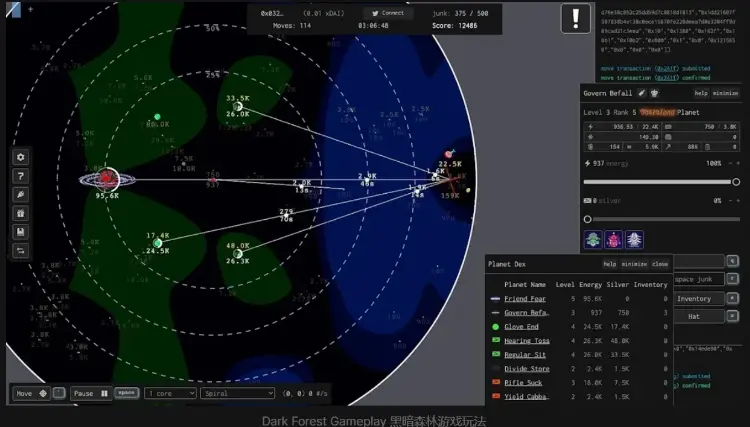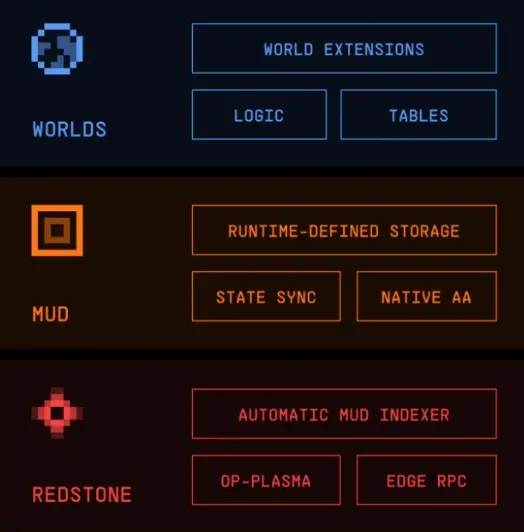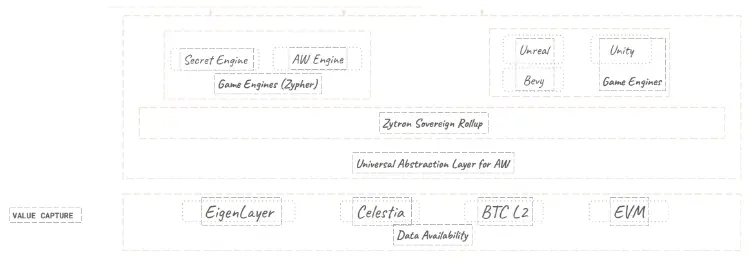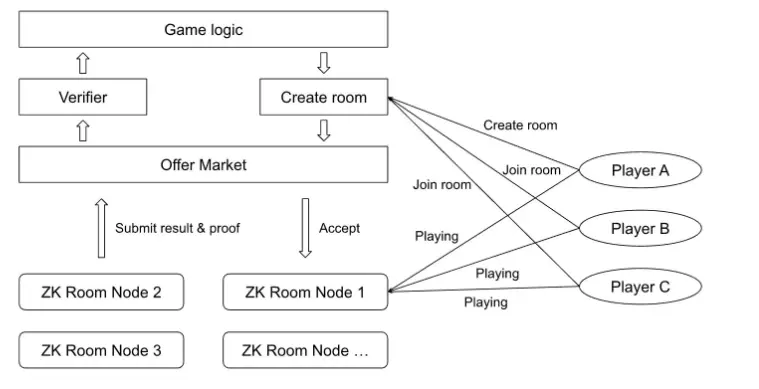 web3.0
web3.0
 From narrative to primitives, 3 types of design paradigms for full-chain game engines Mud, Dojo, and Zypher
From narrative to primitives, 3 types of design paradigms for full-chain game engines Mud, Dojo, and Zypher
From narrative to primitives, 3 types of design paradigms for full-chain game engines Mud, Dojo, and Zypher
Is the autonomous world/full-chain game a boring toy for Crypto technology geeks? Or is it a cult type MeMe?
Questions about these issues are due to the abstract and complex definition of autonomous world/full-chain games and the current simple to rudimentary game interface and interaction, which makes most game players bored and addicted.
But in fact, although autonomous world/full-chain games have a game experience that is completely different from other paradigm games, it does not mean that it is not fun. As a veteran game player, DarkForest, the first full-chain game, is the only game in 5 years that I played overnight for two days in a row.

If the space of other games is a sandbox, and the game content is a simulation of the secret room game, then the space of the full-chain game is digital physical reality, and the full-chain game The content of the chain game is a simulation of real-world games. While playing Dark Forest, I truly experienced the cosmic horror that penetrated my bones in Liu's "The Three-Body Problem".
Basic Narrative of Autonomous World/Full-Chain Game
The Lattice team defined the connotation and extension of the concept of autonomous world/full-chain game in the "Autonomous World Declaration" and defined the autonomous world/ Full-chain games are distinguished from Web2.5 games.
Autonomous world/full-chain game is a self-sustaining open game system based on digital physical reality and basic laws. It has permanence, immutability and permissibility.
A full-chain game in the narrow sense is an autonomous world. Its playability does not come from the game content (cosmic view, plot,
music, vertical painting, etc.) and game goal provided by the game developer. (Levels, achievements, dungeons, national wars), etc., come from the real experience of the sub-world (Sub-World) built by players in their own world.
The construction logic of autonomous world/full-chain games is objects - basic rules - digital physical reality, which respectively correspond to entities - components - systems of the game engine ECS framework.
In a sense, autonomous world/full-chain games are exploring the construction of the next layer of virtual world based on the information bits of the real world we live in. Or we can use Musk’s term to nest a new virtual world based on a virtual world. This is consistent with the famous scene in the American science fiction TV series "Rick and Morty" where a multi-layered world is infinitely recursively nested.
The implementation paradigm of new primitives for autonomous world/full-chain games
The above is a simplified narrative of autonomous world/full-chain games. To instantiate the narrative of an autonomous world/full-chain game, we need a complete set of new primitives composed of blockchain, game engine, middleware, game client and other engineering modules.
The new primitives of autonomous world/full-chain games need to solve 3 core problems:
- The scalability problem of the blockchain. Achieving the persistence, immutability, and permission-free nature of autonomous world/full-chain games requires all game states and logic to be uploaded to the chain, which places very high requirements on the scalability and programmability of the blockchain.
- Tick loop problem. The blockchain is a sequential state machine along the direction of time, and is not suitable for managing the state of an autonomous world/full-chain game. Because autonomous worlds/full-chain games have a large number of cyclic events, such as sunrise and sunset, patrol routes of mobs, etc. Moreover, the blockchain is a passive state update, requiring users to send Transactions to trigger events.
- How to realize the immutability of digital physical reality and the openness and permission-free nature of basic rules and object addition, modification, and deletion.
In response to the above three core issues, the autonomous world/full-chain game primitives of the autonomous world/full-chain game teams Lattice, Dojo and Zypher Games teams have given different solutions.
The primitives of Lattice’s autonomous world/full-chain game are composed of the Worlds development framework, the MUD game engine and the Redstone underlying consensus protocol.

World Development Framework. World is a smart contract development framework built on MUD V2's new storage engine STORE. STORE is a storage engine defined by Runtime. MUD V2 replaces the Solidity compiler's storage model with it.
World is a new paradigm for EVM applications. You can think of it like a community computer: it exists as a multiplayer core, accepting contributions from anyone on the chain - whether it's code or state.
World has programmable access management capabilities, allowing any state or logic to control which accounts (or other logic) can access them. This makes it possible to build trust hierarchies and allows untrusted smart contracts to read state and participate in rules without having them write directly to storage.
MUD Game Engine. MUD full-chain game engine is the first full-chain game engine in the EVM ecosystem. MUD V2 consists of runtime-defined storage engine STORE, state synchronization, and native AA (account abstraction) modules.
New features of MUD V2 allow the creation of a set of digital physics that determines how the world is created and transformed, and subsequently destroys root access to itself; always adhering to a set of specifications without limiting the feature set Rules: Anyone in the world - humans and machines - can interact with these rules and build social and engineering devices on top of them.
Redstone underlying consensus protocol. Redstone is OP Stack’s first Plasma Rollup L2 instance, built specifically for developers of on-chain gaming and autonomous worlds in partnership with Lattice and Optimism.
It operates similarly to traditional OP Rollup, but unlike OP Rollup which publishes the input state to L1, Redstone only publishes a data commitment hash. The input state corresponding to the input commitment is stored off-chain by the data availability provider. To ensure that the input state corresponding to the input commitment is available, there is a data availability challenge contract on L1 that allows anyone to challenge the data commitment in the event of a problem with the provider.
Dojo was a Fork project of MUD in the early days, dedicated to implementing MUD using Cario language on Starknet. The current primitives of Dojo's autonomous world/full-chain game are composed of the Cario state and smart contract development framework, the full-chain game engine SOZO CLI, the index and RPC service middleware TORLL, and the KATANA underlying consensus protocol.
Cario state and smart contract development framework. Dojo provides a standardized method for building full-chain games/autonomous worlds using Cario smart contracts, simplifying the development process and allowing developers to focus on logic rather than architecture.
Full chain game engine SOZO CLI . SOZO CLI supports the creation, construction, testing and deployment of full-chain game/autonomous world instances, supports the production of new components and systems, and assists in the management of multiple autonomous world instances.
Index and RPC service middleware TORII . TORII automatically indexes all contract states. Automatically expose state via GraphQL API or gRPC. Developers no longer need to generate custom indexers.
KATANA underlying consensus protocol. KATANA is a customizable Starknet development network that allows for rapid iteration of game logic.
The main difference between Dojo and MUD is the use of ZK-Rollup as the underlying consensus protocol and Cario language as the development language.
Different from the Dojo forked MUD - adaptive and specialized full-chain game/autonomous world engine development path, Zypher Game is a completely native full-chain game/autonomous world engine based on ZK technology. Zypher Game's full-chain game/autonomous world primitives are mainly composed of the game engine Secret Engine, AW Engine and the underlying consensus protocol Zytron Kit.

Secret Engine , provides a set of SDK driven by zk that can safely perform verifiable encryption calculations, ensuring that the elements required for the game are on the chain To keep it sealed, the existing service zk-shuffle-as-a-service has helped more than 3 full-chain card games to encrypt and shuffle cards.
AW Engine . AW Engine is composed of various services SDK driven by ZK, including Gadgets toolbox, APP dedicated circuit, on-chain verification nodes, etc. AW Engine enables plug-and-play ZK functionality, ZK circuit composability, and third-party integration with RISC ZeroZK virtual machines.
AW Engine has also innovatively developed the Z4 engine specifically for multiplayer real-time games. Z4 uses zk-rollup to expand the concurrency of multiplayer games. The core is the fast way of state changes. z4 allows the game to There is no need to broadcast global status on the source chain but it is converted into cheap local status changes, which can effectively reduce user fees and support millions or even billions of tps.

Zytron Kit . Zytron Kit is a modular Sovereign L3 Rollup build stack. Zytron Kit consists of sovereign L3 Rollup, Zypher Games' game engine as a precompiled contract, server sharding, data compatibility, and customized networking.
Zytron Kit is tailor-made for developers to build autonomous worlds, mini-strategy games or migrate AAA games on-chain at minimal cost without a steep learning curve, allowing them to migrate assets on-chain , game logic and data storage, while retaining production-grade UE.
In addition to AW Engine and Zytron Kit, Zypher Game also has a proof computing market for mobile gamers, and Zypher is also integrating with some game-related infrastructure. .
Recently, Zypher Game has also reached cooperation with Risc Zero and Celesita. In partnership with Risc Zero, Zypher Game integrates Risc Zero's universal ZK virtual machine into the Zypher game engine and extends Risc Zero's use cases through the inclusion of game-specific SDK extensions. In cooperation with Celesita, Zypher Game uses Celesita's Roll Kit tool to build Zytron Kit and uses Celesita as the default DA layer of Zytron Kit.
Latest, Zypher Games launched the B ² Network test network, indicating that it is supporting the B TC ecosystem and will help the B TC ecosystem develop on-chain games through ZKP and AI technology.
Summary
From narrative to primitives, in order to deal with the scalability issues of the blockchain, the Tick cycle issue, the immutability and basic laws of digital physical reality, and the openness of objects , the new primitives of autonomous world/full-chain games give different solutions. Lattice chose the OP-Rollup path to drastically change the EVM consensus machine state mechanism, while Zypher Game and Dojo chose to use ZKP to trustlessly compress state data and transfer verification to off-chain calculations.
Three options, each with its own merits. Lattice's implementation paradigm has advantages in EVM compatibility and developer friendliness. Dojo Game's development environment and ecology-specific adaptations for Starknet. Zypher chose to use the native digital physical characteristics of modular DA, RiscZero Zk co-processor, and Bitcoin UTXO to achieve a solution that combines trustlessness, scalability, and performance flexibility.
In addition to the above three paradigms, there are also Argus's World Engine and Nervous (CKB)'s full-chain game/autonomous world primitives based on the eUTXO state data structure.
Currently, the full-chain game/autonomous world is in the technological embryonic stage of Geithner’s emerging technology growth curve. At this stage, there are more developers than players, and many test games are 4399-like casual games. This does not prevent crypto venture capital funds from making repeated bets in this emerging field. Because in their eyes, the current state of the full-chain game/autonomous world is like a train that could not outrun the carriage in the 1820s. It is not a problem, but an opportunity.
The above is the detailed content of From narrative to primitives, 3 types of design paradigms for full-chain game engines Mud, Dojo, and Zypher. For more information, please follow other related articles on the PHP Chinese website!

Hot AI Tools

Undresser.AI Undress
AI-powered app for creating realistic nude photos

AI Clothes Remover
Online AI tool for removing clothes from photos.

Undress AI Tool
Undress images for free

Clothoff.io
AI clothes remover

Video Face Swap
Swap faces in any video effortlessly with our completely free AI face swap tool!

Hot Article

Hot Tools

Notepad++7.3.1
Easy-to-use and free code editor

SublimeText3 Chinese version
Chinese version, very easy to use

Zend Studio 13.0.1
Powerful PHP integrated development environment

Dreamweaver CS6
Visual web development tools

SublimeText3 Mac version
God-level code editing software (SublimeText3)

Hot Topics
 1393
1393
 52
52
 1205
1205
 24
24
 Recommended essential software for currency contract parties
Apr 21, 2025 pm 11:21 PM
Recommended essential software for currency contract parties
Apr 21, 2025 pm 11:21 PM
The top ten cryptocurrency contract exchange platforms in 2025 are: 1. Binance Futures, 2. OKX Futures, 3. Gate.io, 4. Huobi Futures, 5. BitMEX, 6. Bybit, 7. Deribit, 8. Bitfinex, 9. CoinFLEX, 10. Phemex, these platforms are widely recognized for their high liquidity, diversified trading functions and strict security measures.
 What is a quantum chain? What are the quantum chain transactions?
Apr 21, 2025 pm 11:51 PM
What is a quantum chain? What are the quantum chain transactions?
Apr 21, 2025 pm 11:51 PM
Quantum Chain (Qtum) is an open source decentralized smart contract platform and value transmission protocol. 1. Technical features: BIP-compatible POS smart contract platform, combining the advantages of Bitcoin and Ethereum, introduces off-chain factors and enhances the flexibility of consensus mechanisms. 2. Design principle: realize on-chain and off-chain data interaction through main control contracts, be compatible with different blockchain technologies, flexible consensus mechanisms, and consider industry compliance. 3. Team and Development: An international team led by Shuai Chu, 80% of the quantum coins are used in the community, and 20% rewards the team and investors. Quantum chains are traded on Binance, Gate.io, OKX, Bithumb and Matcha exchanges.
 What does cross-chain transaction mean? What are the cross-chain transactions?
Apr 21, 2025 pm 11:39 PM
What does cross-chain transaction mean? What are the cross-chain transactions?
Apr 21, 2025 pm 11:39 PM
Exchanges that support cross-chain transactions: 1. Binance, 2. Uniswap, 3. SushiSwap, 4. Curve Finance, 5. Thorchain, 6. 1inch Exchange, 7. DLN Trade, these platforms support multi-chain asset transactions through various technologies.
 What are the hybrid blockchain trading platforms?
Apr 21, 2025 pm 11:36 PM
What are the hybrid blockchain trading platforms?
Apr 21, 2025 pm 11:36 PM
Suggestions for choosing a cryptocurrency exchange: 1. For liquidity requirements, priority is Binance, Gate.io or OKX, because of its order depth and strong volatility resistance. 2. Compliance and security, Coinbase, Kraken and Gemini have strict regulatory endorsement. 3. Innovative functions, KuCoin's soft staking and Bybit's derivative design are suitable for advanced users.
 How to trade quantum chains
Apr 21, 2025 pm 11:42 PM
How to trade quantum chains
Apr 21, 2025 pm 11:42 PM
The quantum chain (Qtum) transaction process includes three stages: preliminary preparation, purchase and sale. 1. Preparation: Select a compliant exchange, register an account, perform identity verification, and set up a wallet. 2. Purchase quantum chains: recharge funds, find trading pairs, place orders (market orders or limit orders), and confirm transactions. 3. Sell quantum chains: Enter the trading page, select the trading pair and order type (market order or limit order), confirm the transaction and withdraw cash.
 Recommend several apps to buy mainstream coins in 2025 latest release
Apr 21, 2025 pm 11:54 PM
Recommend several apps to buy mainstream coins in 2025 latest release
Apr 21, 2025 pm 11:54 PM
APP software that can purchase mainstream coins includes: 1. Binance, the world's leading, large transaction volume and fast speed; 2. OKX, innovative products, low fees, high security; 3. Gate.io, a variety of assets and trading options, focusing on security; 4. Huobi (HTX), low fees, good user experience; 5. Coinbase, suitable for novices, high security; 6. Kraken, safe and compliant, providing a variety of services; 7. KuCoin, low fees, suitable for professional traders; 8. Gemini, emphasizes compliance, and provides custodial services; 9. Crypto.com, providing a variety of offers and services; 10. Bitstamp, an old exchange, strong liquidity,
 Which Bitcoin futures exchange is global?
Apr 21, 2025 pm 11:18 PM
Which Bitcoin futures exchange is global?
Apr 21, 2025 pm 11:18 PM
The top five Bitcoin futures exchanges rankings are: 1. CME Group: The most trustworthy in the world, attracting institutional investors, and have strong compliance; 2. Coinbase: Specially for retail investors, providing 13 futures contracts, with high ease of use; 3. Binance: High leverage, good liquidity, and large user volume; 4. OKX: Large cumulative trading volume, professional interface, and complete risk management; 5. Kraken: High security, suitable for European market and institutional customers.
 Quantum Chain Exchange Ranking Top 10 Recommended (Updated in 2025)
Apr 21, 2025 pm 11:48 PM
Quantum Chain Exchange Ranking Top 10 Recommended (Updated in 2025)
Apr 21, 2025 pm 11:48 PM
Quantum chains can be traded on the following exchanges: 1. Binance: One of the world's largest exchanges, with large trading volume, rich currency and high security. 2. Sesame Open Door (Gate.io): a large exchange, providing a variety of digital currency transactions, with good trading depth. 3. Ouyi (OKX): operated by OK Group, with strong comprehensive strength, large transaction volume, and complete safety measures. 4. Bitget: Fast development, provides quantum chain transactions, and improves security. 5. Bithumb: operated in Japan, supports transactions of multiple mainstream virtual currencies, and is safe and reliable. 6. Matcha Exchange: a well-known exchange with a friendly interface and supports quantum chain trading. 7. Huobi: a large exchange that provides quantum chain trading,


